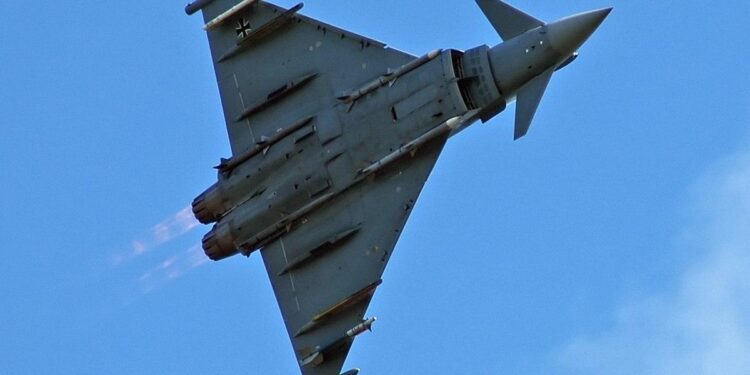Germany is set to bolster its air defense capabilities with a significant order of 20 new Eurofighter Typhoon jets from Airbus, marking a major expansion of its current fleet. The deal underscores Germany’s commitment to enhancing its military readiness amid evolving security challenges in Europe. This acquisition not only strengthens the German Air Force but also reinforces the strategic partnership with Airbus, the principal manufacturer of the multirole combat aircraft.
Germany Strengthens Air Defense Capabilities with New Eurofighter Typhoon Order
The German Ministry of Defence has confirmed a significant procurement of 20 new Eurofighter Typhoon jets from Airbus, marking a strategic move to bolster the nation’s air defense framework. This order aims to enhance the Luftwaffe’s operational readiness and ensure state-of-the-art aerial superiority amid evolving geopolitical challenges in Europe. The incoming fleet will be equipped with the latest avionics, radar systems, and advanced weaponry, positioning Germany at the forefront of European air combat capabilities.
Key upgrades and features of the new Eurofighter Typhoons include:
- Enhanced AESA radar technology for improved target detection
- Integration of next-generation air-to-air and air-to-ground missiles
- Upgraded electronic warfare systems for increased survivability
- Extended service life with modular upgrade potential
| Specification | Details |
|---|---|
| Delivery Timeline | 2025-2029 |
| Cockpit | Fully digital glass cockpit |
| Engines | Two Eurojet EJ200 turbofans |
| Max Speed | Mach 2.0+ |
| Range | 1,800 km (combat radius) |
Strategic Implications for European Security and NATO Collaboration
The augmentation of Germany’s Eurofighter Typhoon fleet marks a pivotal enhancement in the country’s air defense capabilities, reinforcing its position as a cornerstone of European security. This acquisition not only ensures the modernization of the Luftwaffe’s operational readiness but also serves as a clear signal of commitment to deterring emerging threats in an increasingly volatile geopolitical landscape. The additional 20 jets will provide greater flexibility in patrolling strategic airspace and responding swiftly to potential incursions, directly contributing to regional stability.
From a NATO collaboration perspective, the expanded fleet strengthens interoperability and collective defense mechanisms among allied nations. Germany’s investment facilitates more cohesive joint exercises and coordinated missions, underpinning the alliance’s deterrence posture. Key strategic benefits include:
- Enhanced Rapid Response: Faster deployment capabilities across member states.
- Improved Surveillance: Augmented aerial reconnaissance shared within NATO networks.
- Technology Integration: Streamlined communication and combat systems interoperability.
| Capability | Benefit to NATO |
|---|---|
| Air Superiority | Dominance in contested airspace |
| Multi-role Flexibility | Versatile mission profiles for joint operations |
| Advanced Avionics | Improved situational awareness across the alliance |
Recommendations for Integrating Advanced Features in the Expanded Fleet
To maximize the operational impact of the new Eurofighter Typhoons, it is essential to integrate cutting-edge avionics and sensor fusion technologies. Prioritizing open architecture systems will allow seamless updates and interoperability with allied forces. Additionally, upgrading electronic warfare suites with AI-driven threat detection can enhance survivability against evolving threats in contested airspaces. Training modules must also evolve in tandem, employing virtual and augmented reality to prepare pilots for next-generation combat scenarios effectively.
Key Focus Areas for Integration:
- Implementation of advanced radar and stealth enhancements for reduced detectability
- Integration of AI-powered decision support systems for real-time tactical analysis
- Enhanced network-centric warfare capabilities enabling multi-platform coordination
- Use of modular payloads to adapt quickly to mission-specific equipment
| Feature | Benefit | Implementation Phase |
|---|---|---|
| Sensor Fusion | Improved situational awareness | Phase 1 (2025-2026) |
| AI Threat Detection | Faster threat response | Phase 2 (2027-2028) |
| Network Connectivity | Joint force collaboration | Phase 3 (2028-2030) |
The Way Forward
With this significant order for 20 additional Eurofighter Typhoons, Germany reinforces its commitment to maintaining a modern and capable air force amid evolving security challenges. The expansion of the fleet underscores both the strategic importance of the Eurofighter program and Airbus’s role as a key defense partner. As production and delivery progress, this move will bolster Germany’s air defense capabilities and contribute to broader European defense cooperation in the years ahead.
















